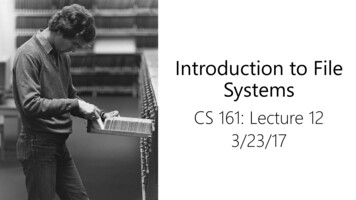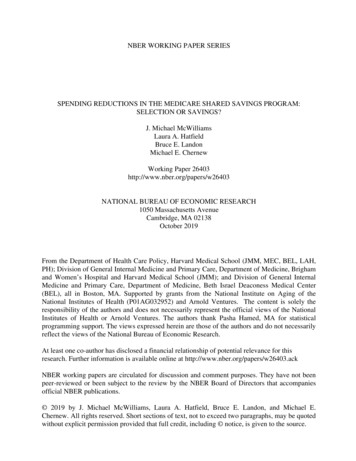
Transcription
Introduction to FileSystemsCS 161: Lecture 123/23/17
Why Do File Systems Exist? From the perspective of an OS, a storage device is a big, linear array of bytes Sector: Smallest amount of data that the device can read or write in asingle operation Most applications want a higher-level storage abstraction that provides: String-based naming of application data (e.g., “photos/koala.jpg” insteadof “the bytes between sectors 12,802 and 12,837”) Automatic management of free and allocated sectors as files are createdand deleted Performance optimizations like: Caching of recently read/written data Prefetching of preexisting data that is likely to be read in the future Some notion of reliability in the presence of application crashes, OScrashes, and unexpected power failures
Core File System Abstractions:Files and Directories A file is a named, linear region of bytes that can grow and shrink Associated with metadata like: a user-visible name (e.g., “koala.jpg”) a size in bytes access permissions (read/write/execute) statistics like last modification time a seek position if open File also has a low-level name (e.g., Linux inode number) that the file system uses tolocate the file data on a storage device File systems are typically agnostic about the contents of the file (i.e., applicationsdecide how to interpret file bytes) A directory is a container for other files and directories Typically contains pairs of user-visible-name, low-level-name Nested directories create hierarchical trees (e.g., “/home/todd/photos/koala.jpg”)
Files as Single Extents (1960s File Systems) A file’s metadata consists of: A starting sector for the file data The number of bytes in the file(note that the last sector may notbe completely full)Metadata Advantages:Contiguoussectors Simple! Metadata is small Efficiently supports sequential andrandom IO Disadvantages: For a new file, how much spaceshould be preallocated? What happens if the file needs togrow beyond its allocation, orshrink? External fragmentation
Files as Collections of Extents (IBM OS360, ext4) Advantages:Contiguoussectors If extents are large, sequential IOalmost as fast as with a single extent Random IO almost as efficient as withsingle extent (offset calculations a littletrickier) Metadata is small. Disadvantages: Most of the singleextent design challenges are multiplied!. How large should a file’s initial extentsbe? What happens if a file needs to grow orshrink? External fragmentation not as bad, butdepending on design, may haveinternal fragmentation inside eachextent
Files as Linked Lists (FAT: MSDOS, SSD memory cards) Advantages Easy to shrink and grow files Low internal and externalfragmentation Calculating sector offsets forsequential IO is easy Disadvantages Sequential IO requires a lot of seeks Random IO is difficult—where doesthe target sector live? Must store pointer information at theend of each data block
Files as Flat Indices Advantages Easy to calculate offsets for bothsequential and random IO Low internal and externalfragmentation Disadvantages Maximum file size is fixed by thenumber of entries in an index Sequential IO requires a lot of seeks
Files as Hybrid Indices (FFS, ext2, ext3) Top-level index contains directpointers, indirect pointers, doublyindirect pointers, etc. Advantages: Efficient for small files: don’t need tomaterialize indirect blocks There is still a maximum file size, but it’sreally big Low internal and external fragmentation Disadvantages: Reading or writing a single data blockmay require multiple disk accesses tofetch indirection info Even if indirection info is cached,reading or writing adjacent blocks mayrequire extra seeks if those blocks arenot physically adjacent on disk
Free Space Management Fixed-sized blocks: File systems typically use a bitmap to indicatewhich blocks are in use Allocation metadata is very compact Finding a single free block is straightforward . . . . . . but finding a *contiguous* region of N free blocks is tedious withoutauxiliary data structures Extents: File system can implement “on-disk malloc” File system breaks the disk into discrete-sized extents (e.g., 4KB, 8KB,12KB, ,4MB), or arbitrarily-sized extents sorted by size File system maintains a list of unallocated extents To allocate an extent for a request of size N bytes, file system uses apolicy (e.g., best-fit, worst-fit, first-fit, etc., each of which has trade-offsbetween internal fragmentation, external fragmentation, and speed offinding a match)
kern/include/kern/sfs.h/* File#define#define#definetypes for sfi type */SFS TYPE INVAL0SFS TYPE FILE1SFS TYPE DIR2/* Should not appear on disk *//* On-disk inode */struct sfs dinode {uint32 t sfi size;/* Size of this file (bytes) */uint16 t sfi type;/* One of SFS TYPE * above */uint16 t sfi linkcount;/* # hard links to this file */uint32 t sfi direct[SFS NDIRECT]; /* Direct blocks */uint32 t sfi indirect;/* Indirect block */uint32 t sfi dindirect;/* Double indirect block */uint32 t sfi tindirect;/* Triple indirect block */uint32 t sfi waste[128-5-SFS NDIRECT]; /* pad to 512 bytes */};
SFS: Managing Free Space In SFS, the block size is 512 bytes/* In-memory info for a file systemstruct sfs fs {struct bitmap *sfs freemap;bool sfs freemapdirty;struct lock *sfs freemaplock;/* Other fields . . . */};*//* blocks in use are marked 1 *//* true if freemap modified *//* lock for freemap/superblock */ In SFS, sizeof(struct sfs dinode) is 512 bytes, which is the block size! So, SFS allows blocks to live anywhere on disk—to allocate/deallocate an inode,SFS manipulates the block bitmap The struct sfs direntry::sfd ino field contains a block number (the root directory isalways inode 1) SFS differs from most file systems, which place inodes in specific regions of thedisk (e.g., inodes blocks should be close to the corresponding file data blocks)
Walking A Directory Path /p0/p1/p2/ The inode for the root directory has afixed, known value So, to traverse a directory path, we first set: curr inode to the root directory’s inode pathIndex to 0 curr path to path components[pathIndex] Then, we iteratively: Read the data associated with curr inode Find the directory entry (i.e., the path,inode pair) for which dir entry.path curr path Set curr inode to dir entry.inode, and setcurr path to path components[ i]
More Fun With Directories Using full path names can be tedious, so most file systems associatea “current working directory” with each process The current working directory is stored in the struct proc When a process requires the OS to resolve a path, the OS checks whetherthe first character in the path is “/” If so, start resolving at the root directory If not, start resolving at the current working directory Most file systems support the special directory entries ”.” and “.” “.” refers to the directory itself (e.g., “./foo.txt” refers to a file in thedirectory) “.” refers to the parent directory (e.g., “./foo.txt” refers to a file in theparent directory)
Multiple Directory Entries Can Point To The Same File! A “soft link” or “symbolic link” is a file that containsthe name of another file When the OS encounters a symbolic link, itcontinues pathname resolution using the pathname in the link echo “hello” /target/file ln –s /target/file /path/of/symlink ls –l /target/file /path/of/symlink-rw-rw-r-- 1 jane admins 6 Mar 22 22:01 /target/filelrwxrwxrwx 1 jane admins 6 Mar 22 22:01 /path/of/symlink - /target/file
Multiple Directory Entries Can Point To The Same File! A “hard link” directly references aninode number The file system maintains a referencecount for each file When you hard link to a file, youincrement the ref count When you delete a hard link, youremove the link from its directory, anddecrement the ref count for the file A file’s data is only deleted when its refcount drops to zero echo “hello” /target/file ln /target/file /path/of/hardlink ls –l /target/file /path/of/hardlink-rw-rw-r-- 2 jane admins 6 Mar 22 22:01 /target/file-rw-rw-r-- 2 jane admins 6 Mar 22 22:01 /path/of/hardlink
The Virtual File System (VFS) Interface In The Olden Days, a particular OS could only use a single,baked-in file system A VFS defines an abstract, generic interface that a file systemshould present to the OS A particular file system implements the abstract VFS methods, and theOS only interacts with the file system through those VFS methods In principle, the core OS doesn’t need to know anything about theinternal implementation of the file system! A VFS makes it easy for a single OS to run one (or more!) filesystems of the user’s choice Ex: A Linux machine might simultaneously use ext3 for locally storingfiles, and NFS for storing files on remote servers
OS161’s VFS: kern/include/vfs.h/* Abstract low-level file. */struct vnode {int vn refcount;struct spinlock vn countlock;struct fs *vn fs;void *vn data;const struct vnode ops *vn ops;};/*/*/*/*/*Reference count */Lock for vn refcount */Filesystem vnode belongs to */Filesystem-specific data */Functions on this vnode */struct vnode ops {int (*vop read)(struct vnode *file, struct uio *uio);int (*vop write)(struct vnode *file, struct uio *uio);int (*vop stat)(struct vnode *object, struct stat *statbuf);//.other vops.};
File also has a low-level name (e.g., Linux inode number) that the file system uses to locate the file data on a storage device File systems are typically agnostic about the contents of the file (i.e., applications decide how to interpret file bytes) A directory is a container for other files and directories










